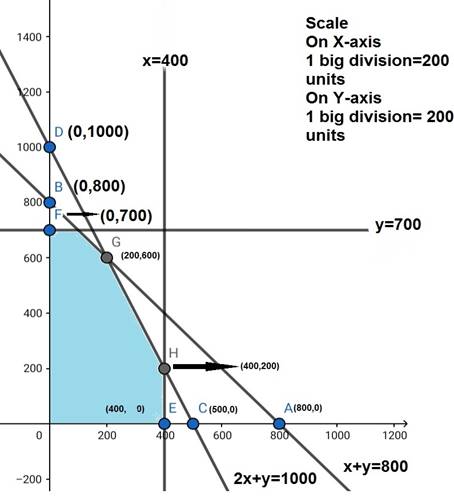A company produces two types of leather belts, say type A and B. Belt A is a superior quality and belt B is of a lower quality. Profits on each type of belt are 2 and 1.50 per belt, respectively. Each belt of type A requires twice as much time as required by a belt of type B. If all belts were of type B, the company could produce 1000 belts per day. But the supply of leather is sufficient only for 800 belts per day (both A and B combined). Belt A requires a fancy buckle and only 400 fancy buckles are available for this per day. For belt of type B, only 700 buckles are available per day.
How should the company manufacture the two types of belts in order to have a maximum overall profit?
Let the company produces x belts of types A and y belts of type B. Number of belts cannot be negative. Therefore, x,y ![]() 0.
0.
It is given that leather is sufficient only for 800 belts per day (both A and B combined).
Therefore,
x + y ![]() 800
800
It is given that the rate of production of belts of type B is 1000 per day. Hence the time taken to produce y belts of type B is ![]() .
.
And, since each belt of type A requires twice as much time as a belt of type B, the rate of production of belts of type A is 500 per day and therefore, total time taken to produce x belts of type A is ![]()
Thus, we have,
![]()
Or, 2x + y ![]() 1000
1000
Belt A requires fancy buckle and only 400 fancy buckles are available for this per day.
x ![]() 400
400
For Belt of type B only 700 buckles are available per day.
y ![]() 700
700
profits on each type of belt are Rs 2 and Rs 1.50 per belt, respectively. Therefore, profit gained on x belts of type A and y belts of type B is Rs 2x and Rs 1.50y respectively. Hence, the total profit would be Rs(2x + 1.50y). Let Z denote the total profit
Z = 2x + 1.50y
Thus, the mathematical formulation of the given linear programming problem is;
Max Z = 2x + 1.50y subject to
x + y ![]() 800
800
2x + y ![]() 1000
1000
x ![]() 400
400
y ![]() 700
700
First we will convert these inequations into equations as follows:
x + y = 800
2x + y = 1000
x = 400
y = 700
Region represented by x + y = 800
The line x + y = 800 meets the coordinate axes at A(800,0) and B(0,800) respectively. By joining these points we obtain the line x + y = 800. Clearly (0, 0) satisfies the x + y ![]() 800. So, the region which contains the origin represents the solution set of the inequation x + y
800. So, the region which contains the origin represents the solution set of the inequation x + y ![]() 800.
800.
Region represented by 2x + y ![]() 1000
1000
The line 2x + y = 1000 meets the coordinate axes at C(500,0) and D(0,1000) respectively. By joining these points we obtain the line 2x + y = 1000. Clearly (0, 0) satisfies the 2x + y ![]() 1000. So, the region which contains the origin represents the solution set of the inequation 2x + y
1000. So, the region which contains the origin represents the solution set of the inequation 2x + y ![]() 1000.
1000.
Region represented by x ![]() 400
400
The line x = 400 will pass through (400,0). The region to the left of the line x = 400 will satisfy the inequation x ![]() 400
400
Region represented by y ![]() 700
700
The line y = 700 will pass through (0,700). The region to the left of the line y = 700
will satisfy the inequation y ![]() 700.
700.
Region represented by x ![]() 0, y
0, y ![]() 0 :
0 :
Since, every point in the first quadrant satisfies these inequations. So, the first quadrant is the region represented by the inequations x ![]() 0 and y
0 and y ![]() 0.
0.
The feasible region determined by the system of constraints x + y ![]() 800, 2x + y
800, 2x + y ![]() 1000, x
1000, x ![]() 400,
400,
y ![]() 700
700

The corner points are F(0,700), G(200,600), H(400,200), E(400,0). The values of Z at these corner points are as follows

The maximum value of Z is 1300 which is attained at G(200,600).
Thus, the maximum profit obtained is Rs 1300 when 200 belts of type A and 600 belts of type B are produced.